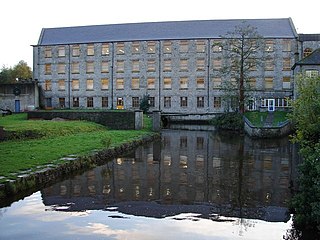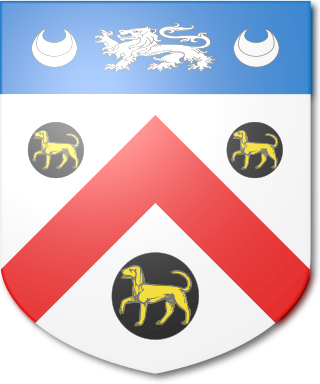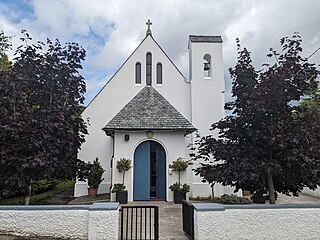
Wulfstan was an English Benedictine monk who served as Bishop of Worcester from 1062 to 1095. He was the last surviving pre-Conquest bishop. Wulfstan is a saint in the Western Christian churches.

Celbridge is a town and townland on the River Liffey in County Kildare, Ireland. It is 23 km (14 mi) west of Dublin. Both a local centre and a commuter town within the Greater Dublin Area, it is located at the intersection of the R403 and R405 regional roads. As of the 2022 census, Celbridge was the third largest town in County Kildare by population, with 20,601 residents.

Straffan is a village in County Kildare, Ireland, situated on the banks of the River Liffey, 25 km upstream of the Irish capital Dublin. As of the 2016 census, the village had a population of 853, a nearly two-fold increase since the 2006 census.
Ardclough, officially Ardclogh, is a village and community in the parish of Kill, County Kildare, Ireland. It is two miles (3 km) off the N7 national primary road. It is the burial place and probable birthplace of Arthur Guinness, who is said to have returned to the maternal homestead of the Reads at Huttonread to give birth in the tradition of the time.
County Kildare in the province of Leinster, Ireland, was first defined as a diocese in 1111, shired in 1297 and assumed its present borders in 1836. Its location in the Liffey basin on the main routes from Dublin to the south and west meant it was a valuable possession and important theatre of events throughout Irish history.

Oughterard is an ecclesiastical hilltop site, graveyard, townland, and formerly a parish, borough and royal manor in County Kildare, nowadays part of the community of Ardclough, close to the Dublin border. It is the burial place of Arthur Guinness.

Sir Thomas Allen, 1st Baronet was the eldest son of John Alen of St. Wolstan's, near Celbridge, County Kildare and Anne, daughter of Thomas Dillon of Riverstown, County Meath. He was the grandnephew of John Alan, Lord Chancellor of Ireland, who acquired St Wolstan's on the dissolution of the monasteries.

Celbridge Abbey is located in Celbridge, County Kildare in Ireland.
Events from the year 1536 in Ireland.
Castledillon is a civil parish on the banks of the River Liffey near Straffan, County Kildare in Ireland. The civil parish, which is approximately 4.4 km2 (1.7 sq mi) in area, contains the townlands of Castledillon Lower and Castledillon Upper.

Kilteel is the name of a village, townland and civil parish located in the barony of South Salt, County Kildare, Ireland. The townland of Kilteel Upper contains the remains of a church with a decorated Romanesque chancel arch, the ruins of a 13th-century preceptory of the Knights Hospitaller and a well-preserved 15th-century tower house. The historic settlement is located on the southwest corner of the English Pale and served an important function as a border fortress during the medieval period.
Sir Gerald Aylmer was an Irish judge in the time of Henry VIII, who played a key part in enforcing the Dissolution of the Monasteries. His numerous descendants included the Barons Aylmer.

Leixlip is a town in north-east County Kildare, Ireland. Its location on the confluence of the River Liffey and the Rye Water has marked it as a frontier town historically: on the border between the ancient kingdoms of Leinster and Brega, as an outpost of The Pale, and on Kildare's border with County Dublin. Leixlip was also a civil parish in the ancient barony of Salt North.
Sir John Alan was a leading English-born statesman in sixteenth century Ireland. He was a member of the Irish House of Commons, and held the offices of Master of the Rolls in Ireland, Chancellor of the Exchequer of Ireland and Lord Chancellor of Ireland. Though he was childless himself, one of his brothers, William, founded a prominent landowning dynasty in County Kildare. The family's holdings included lands at Celbridge, St. Wolstan's and Kilteel, County Kildare, as well as substantial lands in County Dublin. They also acquired a baronetcy.
Adam de Hereford was one of the first generation of Norman colonisers in Ireland.

St. Wolstan's Community School is an all-female community school in Celbridge, County Kildare, Ireland. It's under the trusteeship of the Catholic Archbishop of Dublin, the Holy Faith Sisters and Kildare and Wicklow Education and Training Board. It is the only all-girls community school in Ireland.

The Augustinian Friary of the Most Holy Trinity was an Augustinian Roman Catholic Priory, founded c. 1259, by the family of Talbot on the south bank of the river, in what is now Crow Street, Dublin. At the time the priory was built, it was just outside the city walls. The Friary most likely followed the design of the parent priory Clare Priory in the town of Clare, Suffolk (England). The Friary was suppressed in 1540 when it was described as a "church with belfry, a hall and dormitory". The friars continued to operate in secret within the city. and there are several mentions of them in the city archives until the late 1700s when they consecrated a new church.

Donaghcumper Church is a ruined medieval church in Celbridge, Ireland. On the Record of Monuments and Places it bears the code KD011-013.
John Le Decer was a fourteenth-century Mayor of Dublin, who had a notable record of charitable works and civic improvement.













